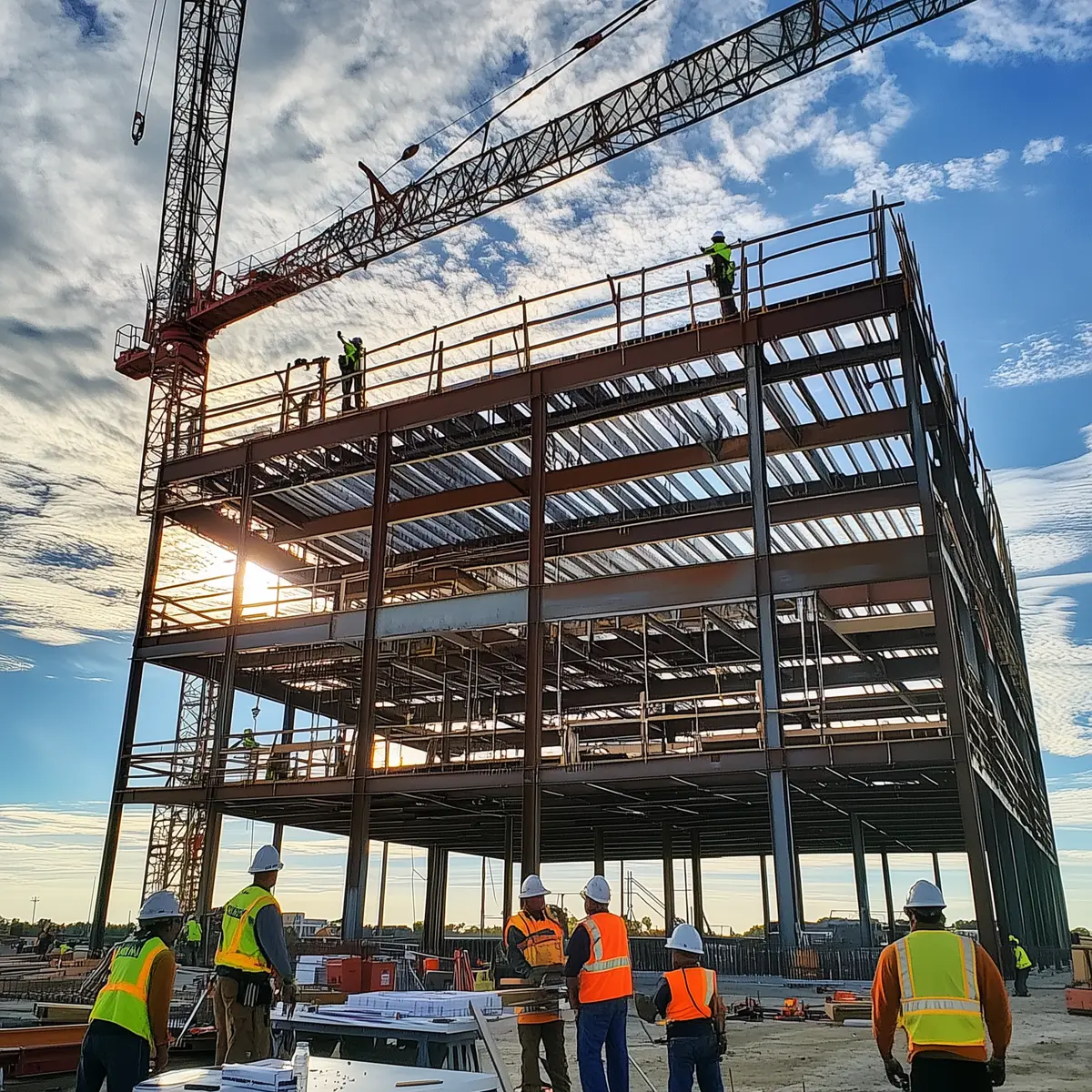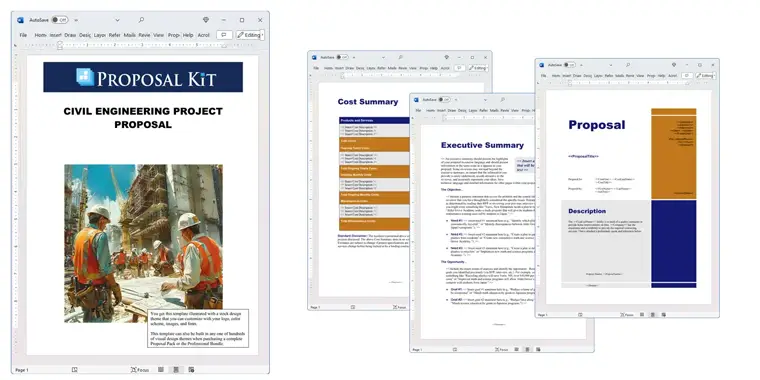How to write your Civil Engineering Project Proposal
We include this 29 page layout with every Proposal Pack. If you want this template to have a different visual design theme than the one illustrated here, purchase any Proposal Pack design and create this template using the purchased design theme. This template is included in every Proposal Pack. If you get a Proposal Pack or the Professional, you can also make any variation of this template with different chapters to suit your needs.
We typically include more chapters in the templates than most people will need to give everyone more variety in the chapters they may need. You can trim down a long template by removing pages you do not need or combining multiple chapter topics into one page.
 DOWNLOADABLE, ONE-TIME COST, NO SUBSCRIPTION FEES
DOWNLOADABLE, ONE-TIME COST, NO SUBSCRIPTION FEESYou can also create countless variations of this document to suit your needs using the included library of 2200+ chapters if ordering a Proposal Pack or Professional.
 What Our Clients Say
What Our Clients SayProposal Pack streamlines the process of creating proposals. The templates included speed up the proposal creating process."
Accounts Manager at Contractors Access Equipment
Related Article
Related Video
Related Templates
- Civil Engineering Construction Project Proposal
- Steel Erection Project Proposal
- Post-Construction Cleaning Services Proposal
- Construction Project Proposal (Short)
- Construction Project Proposal RFP Response
- Energy Efficiency Proposal
The Ultimate Guide to Writing a Civil Engineering Project Proposal with Proposal Kit
Writing a civil engineering project proposal can seem complex, especially if you must familiarize yourself with the process. However, it becomes much more straightforward with the right tools and guidance. A proven approach to this challenge is the Proposal Kit template library and Wizard software program. This comprehensive solution offers a step-by-step guide and a wide array of templates tailored for various business needs, including civil engineering projects. Given the size and scope of civil engineering projects, these proposals can be long and complex. The Proposal Kit can create documents of any length from its library of thousands of topics to cover every aspect of a complex project proposal.
If you're responsible for writing a proposal for any of these types of projects, the Proposal Kit can significantly streamline your process.
How Does Proposal Kit Simplify Proposal Writing?
Proposal Kit's templates and software system, including a line item quoting database, make it easier to draft comprehensive and persuasive proposals. This system helps you create detailed cost summaries, quotes, estimates, budgets, and other financial documents crucial to your proposal. The Proposal Kit Professional includes features that let you create custom line item databases to handle the complexities of a large-scale project.
What Types of Projects Are Civil Engineering Project Proposals Written For?
Using the Proposal Kit, you can effectively create civil engineering proposals for many projects. Examples include:
- Infrastructure development (roads, bridges, tunnels)
- Water supply and wastewater treatment plants
- Environmental restoration projects
- Public parks and recreational facilities
- Residential and commercial development
- Transportation systems and planning
- Flood defense mechanisms
- Energy infrastructure
- Telecommunications infrastructure
- Urban planning and development
Chapters this template is built with
To tailor your proposal to a civil engineering project, you might include chapters such as these.
These chapters are just a sample of the thousands in the Proposal Kit, which allows endless customization to meet your specific project needs.
Executive Summary
The Executive Summary serves as the introduction to your proposal, highlighting the critical aspects of your civil engineering project. It succinctly presents the project's purpose, the problems it aims to solve, and the benefits it promises to deliver. This section is crucial as it sets the tone for the proposal and seeks to capture the interest of the reader, offering a compelling overview that encourages further exploration of the document.
Needs Assessment
A Needs Assessment identifies and evaluates the specific needs that the project intends to address. The assessment thoroughly analyzes the current challenges, deficiencies, or gaps in infrastructure or services the project will remedy. By clearly outlining these needs, the proposal demonstrates a deep understanding of the problem at hand and justifies the necessity of the proposed civil engineering project.
Project Cost Summary
The Project Cost Summary provides a comprehensive breakdown of all expected expenses associated with the project, including materials, labor, equipment, and any other direct and indirect costs. This section ensures transparency and helps stakeholders understand the financial implications of the project. It also aids in securing funding or approval by presenting a detailed and justified budget.
Location Analysis
Location Analysis examines the proposed site for the civil engineering project, assessing its suitability based on various factors such as geography, accessibility, environmental impact, and regulatory considerations. This analysis helps identify potential challenges and opportunities associated with the location, contributing to more informed decision-making and planning.
Goals and Objectives
This part of the proposal outlines the primary goals and objectives of the civil engineering project. It details what the project aims to achieve in specific, measurable terms, aligning with the needs and challenges identified in the Needs Assessment. Clear goals and objectives provide direction for the project and criteria for measuring its success.
Project Plan
The Project Plan is a detailed roadmap for executing the project, including timelines, milestones, and deliverables. It outlines the activities necessary to complete the project, assigns responsibilities, and establishes deadlines. This comprehensive planning ensures the project remains on track and stakeholders are aligned on expectations and progress.
Site Planning
Site Planning involves:
- The detailed arrangement and design of physical elements on the project site.
- Considering factors like land use.
- Environmental sustainability.
- Community impact.
This process includes the layout of buildings, infrastructure, and landscaping, ensuring that the project is harmonious with its surroundings and compliant with zoning and land use regulations.
Project Initiation
Project Initiation marks the formal start of the civil engineering project. This phase includes finalizing contracts, assembling project teams, and establishing project management structures. It sets the foundation for project execution, ensuring all necessary resources and permissions are in place.
Project Methods
This section describes the technical methodologies and engineering solutions employed in the project. The methods detail the construction techniques, materials, and technologies you will utilize, demonstrating the project's feasibility and adherence to industry standards.
Outline
The Outline provides a structured overview of the proposal's content, organizing the document into clear sections and subsections. The Outline makes the proposal more manageable to navigate and understand, allowing readers to find specific information quickly.
Project Analysis Overview
Project Analysis Overview evaluates the project's potential impact, including risks, benefits, and expected outcomes. It encompasses various analyses such as risk assessment, environmental impact assessment, and feasibility studies, providing a comprehensive understanding of the project's implications.
Project Management
Project Management details the strategies and processes you will use to oversee the project's execution. It covers team coordination, resource allocation, quality control, and communication plans, ensuring the project is managed efficiently and effectively.
Project Constraints
Project Constraints identify any limitations or restrictions that might impact the project, such as budgetary constraints, time limitations, or resource availability. Acknowledging these constraints early in the planning process allows for developing strategies to mitigate their effects.
Permits and Licenses
This section lists all required permits and licenses for the project, detailing the process for obtaining them and ensuring compliance with local, state, and federal regulations. It demonstrates the project's commitment to legality and regulatory compliance.
Equipment
Equipment outlines the machinery, tools, and technology you will need for the project. Equipment includes the equipment required for construction and any specialized machinery needed to operate the completed infrastructure, ensuring that all necessary resources are identified and planned.
Standards Compliance
Standards Compliance ensures that the project adheres to relevant industry standards, regulations, and best practices. This section details the specific standards that apply to the project and how compliance will be achieved, ensuring safety, quality, and regulatory approval.
Use cases for this template
Transforming Construction Proposals with Proposal Kit
Alex, the owner of Innovative Builds, a budding construction firm, faced a significant challenge. The opportunity to bid on a major urban redevelopment project had arisen, promising substantial growth for his business. However, the competition was fierce, with several well-established companies vying for the same contract. Alex knew that to stand out, he needed a proposal that was not only compelling but also impeccably structured and professionally presented.
Having limited experience in drafting such high-stakes proposals, Alex turned to Proposal Kit. The comprehensive suite of templates and the Wizard software program offered him a lifeline. Starting with the Executive Summary, Alex used the templates to build his proposal methodically, ensuring each section was filled out and tailored to highlight his firm's unique strengths and the innovative approaches they brought to the table.
The Project Cost Summary and Site Planning sections were particularly daunting for Alex. Yet, the Proposal Kit's line item quoting database and financial templates allowed him to estimate costs and present a competitive and realistic budget accurately. The Location Analysis and Project Plan templates helped him articulate a clear vision for the redevelopment, showcasing how his firm would navigate potential challenges and deliver on time and within budget.
When the proposal was finally submitted, the selection committee was impressed by not just the content but also the professional format and the clarity of Alex's vision. Innovative Builds was awarded the contract, marking a pivotal moment in the company's journey. Thanks to Proposal Kit, Alex had not only articulated his firm's potential but also secured its future.
Beating the Deadline with Precision
Jordan, a project manager at Structural Solutions Ltd., was under the gun. A request for proposal (RFP) for a critical infrastructure project had landed on his desk, with a submission deadline that seemed impossible to meet. The project's comprehensive nature required a detailed proposal that showcased the company's technical capabilities, project management methodologies, and financial plan that demonstrated value for money.
With this tight timeline, Jordan sought a solution in the Proposal Kit. The diverse templates and intuitive Wizard software allowed him to start structuring the proposal quickly. However, his integration of AI writing tools with Proposal Kit's templates set Jordan's strategy apart. Using AI to analyze and pull relevant information from Structural Solutions Ltd.'s extensive website, Jordan enriched the proposal with tailored content highlighting the company's past successes and expertise in similar projects.
The AI's assistance writing specific sections like the Project Methods and Project Analysis Overview saved valuable time and added a layer of sophistication to the proposal. The seamless integration of this content into the Proposal Kit templates ensured that the final document was cohesive, comprehensive, and highly personalized.
Jordan submitted the proposal well within the deadline, and the precision of his approach paid off. "Structural Solutions Ltd." was not only shortlisted but ultimately awarded the project, thanks in no small part to Jordan's innovative use of Proposal Kit and AI tools. His ability to deliver under pressure and leverage technology for efficiency became a case study within the company for future proposal writing.
Writing an RFP for Global Impact
Taylor, a volunteer coordinator for the Global Engineering Initiatives non-profit, was tasked with a mission-critical project. The organization aimed to launch a sustainable water supply system in a developing country, requiring the expertise of top-tier civil engineering firms. To attract the right contractors, Taylor needed to create a Request for Proposal (RFP) that was clear, comprehensive, and compelling.
Despite Taylor's passion for the cause, she needed more experience drafting documents of this complexity and scale. Turning to the Proposal Kit for guidance, Taylor could navigate the daunting task confidently. The software's RFP templates and step-by-step instructions helped her outline the project's scope, objectives, and requirements in clear, accessible language.
Critical sections of the RFP, such as the Goals and Objectives, Project Plan, and Standards Compliance, were meticulously written to convey the non-profit's vision and the project's stringent requirements. Taylor also used the Proposal Kit to detail the submission evaluation criteria, ensuring that bidders understood the non-profit's priorities for sustainability, community impact, and technical excellence.
The finished RFP, distributed globally, attracted proposals from some of the world's leading civil engineering firms, eager to contribute to a project of such significance. The Proposal Kit facilitated the clarity and detail of the RFP, ensuring that the non-profit could select a partner who aligned perfectly with its mission and values.
Taylor's initiative and the successful use of Proposal Kit set the stage for a transformative project. They established a template for future RFPs within the organization, showcasing the power of well-written documentation in making a global impact.
Conclusions and Recommendations
Writing a civil engineering project proposal can be manageable. With Proposal Kit, individuals and organizations can easily navigate the proposal writing process, from small businesses like Alex's, employees like Jordan facing tight deadlines, and even volunteers like Taylor working on international projects. The stories of Alex, Jordan, and Taylor highlight how Proposal Kit simplifies the task and enhances the quality of proposals, increasing the chances of success.
As the ultimate solution for writing a civil engineering project proposal, Proposal Kit ensures that your proposals are professional, comprehensive, and persuasive. Start leveraging Proposal Kit today to transform your proposal writing process and secure your next civil engineering project.
Also Known As
This template may also be referred to in different ways or be used in more specialized situations, such as:
- Infrastructure Development Plan
- Construction Project Submission
- Civil Works Design Proposal
- Structural Engineering Initiative
- Urban Development Scheme
- Public Works Planning Document
- Engineering Project Outline
- Environmental Construction Proposal
- Capital Improvement Plan
- Transport Infrastructure Proposal
Abstract
 Creating a successful civil engineering project proposal requires a clear understanding of both the proposal process and project requirements. This comprehensive guide highlights how tools like Proposal Kit can empower civil engineering teams to create winning project proposals for various infrastructure projects, such as roads, bridges, and urban developments.
Creating a successful civil engineering project proposal requires a clear understanding of both the proposal process and project requirements. This comprehensive guide highlights how tools like Proposal Kit can empower civil engineering teams to create winning project proposals for various infrastructure projects, such as roads, bridges, and urban developments.
These templates and software systems streamline the creation of documents, meeting all project objectives and financial requirements. A well-structured engineering proposal not only addresses key milestones and project deadlines but also showcases unique skills and past projects, helping civil engineers confidently present their plans to potential clients.
In developing a civil engineering proposal, it is important to follow a structured proposal format that enhances clarity and ensures all critical information is communicated. The Executive Summary introduces the proposal, emphasizing specific objectives, project scope, and the project's financial requirements. Further, a detailed schedule lays out the project's timeline, highlighting key points and deadlines to manage expectations. Civil engineers must involve team members from the beginning to ensure collaboration, addressing any potential issues or last-minute changes that may arise. The proposal's success largely depends on balancing resources, outlining estimated costs, and demonstrating problem-solving capabilities through past projects. By incorporating these strategies and employing Proposal Kit's extensive resources, civil engineers can deliver results that not only meet but exceed client expectations, positioning their proposal as a winning proposition in the competitive landscape.
 Creating a civil engineering proposal requires more than just technical expertise; it demands a persuasive narrative that aligns with potential clients' expectations and project requirements. To enhance the effectiveness of a civil engineering proposal, one must focus on creating a document that seamlessly integrates compelling project topics with a clear understanding of the project's objectives. By using Proposal Kit, a game changer in proposal writing, civil engineers can prepare documents that adhere to industry standards while being specifically tailored to meet the unique needs of each project.
Creating a civil engineering proposal requires more than just technical expertise; it demands a persuasive narrative that aligns with potential clients' expectations and project requirements. To enhance the effectiveness of a civil engineering proposal, one must focus on creating a document that seamlessly integrates compelling project topics with a clear understanding of the project's objectives. By using Proposal Kit, a game changer in proposal writing, civil engineers can prepare documents that adhere to industry standards while being specifically tailored to meet the unique needs of each project.
The proposal process begins with defining the project's scope and establishing specific objectives that are SMART - Specific, Measurable, Achievable, Relevant, and Time-bound. This approach helps in aligning the proposal with the client's vision and addressing potential issues that might arise during project execution. The engineering proposal should also include a detailed project analysis, evaluating potential risks and benefits to ensure successful project execution.
A well-written proposal includes an in-depth project cost summary, covering all anticipated expenses as well as other expenses like permits and licenses. This transparency in financial planning helps in building confidence among potential clients. The proposal should also emphasize the team's unique skills and qualifications, showcasing past projects that highlight experience relevant to the current situation. This demonstration of expertise is crucial in setting the proposal apart from competitors.
 Using tools like Proposal Kit, which offers an extensive library of templates and easily integrates with AI writing workflows, civil engineering teams can efficiently manage the proposal creation process. This allows for a thorough needs assessment, project planning, and resource allocation, ensuring that the proposal is not only comprehensive but also aligned with project constraints and financial parameters. By addressing all the requirements and highlighting key milestones through well-written sentences and efficient use of words, the proposal stands a greater chance of winning over clients and securing new projects.
Using tools like Proposal Kit, which offers an extensive library of templates and easily integrates with AI writing workflows, civil engineering teams can efficiently manage the proposal creation process. This allows for a thorough needs assessment, project planning, and resource allocation, ensuring that the proposal is not only comprehensive but also aligned with project constraints and financial parameters. By addressing all the requirements and highlighting key milestones through well-written sentences and efficient use of words, the proposal stands a greater chance of winning over clients and securing new projects.
Moreover, the inclusion of visuals such as images and diagrams, along with clear descriptions of the engineering solutions and methodologies, serves to communicate the project's intentions. This approach, coupled with an understanding of the RFP requirements and tips for enhancing proposal submissions, ensures that the final documents serve as a great example of a structured and persuasive engineering proposal.
In conclusion, preparing a civil engineering proposal involves a blend of technical knowledge, planning, and persuasive communication. By using resources like Proposal Kit and focusing on the proposal's structure and content, civil engineers can create documents that not only meet but exceed client expectations and ultimately deliver successful project outcomes.
Frequently Asked Questions
What should I include in a civil engineering project proposal?
A civil engineering project proposal typically includes an executive summary, project background, objectives, scope of work, methodology, timeline, budget estimate, risk assessment, and project team credentials. Each section plays a vital role in communicating the project's value, feasibility, and importance to stakeholders. Combining these elements provides a comprehensive view of the project's goals, processes, and expected outcomes.
How do I determine the project scope and objectives?
Defining the project scope and objectives involves understanding the problem you aim to solve and the outcomes you intend to achieve. Start by identifying the project's purpose and the needs of the stakeholders. Clearly outline the specific tasks, deliverables, and boundaries of the project. Objectives should be SMART (Specific, Measurable, Achievable, Relevant, and Time-bound) to ensure clarity and focus throughout the project lifecycle.
What is the best way to estimate the project budget?
Estimating the project budget requires a detailed breakdown of all potential costs, including materials, labor, equipment, permits, and contingencies. Begin by reviewing historical data from similar projects and consulting industry standards. Engage with suppliers and contractors for current pricing. It is essential to include a contingency reserve to cover unforeseen expenses. A well-documented budget estimate enhances the proposal's credibility and ensures financial preparedness.
How do I conduct a risk assessment for my proposal?
Conducting a risk assessment involves identifying potential risks, evaluating their impact, and developing mitigation strategies. Start by brainstorming possible risks related to technical challenges, environmental factors, regulatory compliance, and financial constraints. Rank the risks based on their likelihood and severity. For each significant risk, propose a mitigation plan that details how the risk will be managed or minimized. This proactive approach demonstrates thorough planning and risk management capabilities.
What should be included in the project timeline?
The project timeline should outline all significant phases and milestones from initiation to completion. Include detailed schedules for the design, procurement, construction, and testing phases. Use Gantt charts or similar tools to visually represent the timeline, specifying start and end dates for each task and identifying dependencies between activities. A clear and realistic timeline helps stakeholders understand the project's progress and ensures timely delivery of each phase.
20% Off Discount
![]() Add To Cart This Word Template
Add To Cart This Word Template
 Add To Cart Proposal Pack for Any Business
Add To Cart Proposal Pack for Any Business
 Add To Cart Proposal Kit Professional
Add To Cart Proposal Kit Professional
 4.7 stars, based on 849 reviews
4.7 stars, based on 849 reviewsProposal Kit chapters used in this template
Cover Letter, Title Page, Table of Contents, Outline, Goals and Objectives, Needs Assessment, Location Analysis, Project Plan, Project Initiation, Project Methods, Project Analysis Overview, Project Background, Project Management, Project Oversight, Site Planning, Materials, Equipment, Permits and Licenses, Resources, Project Constraints, Specifications, Inspection, Project Cost Summary, Project Budget, Project Summary, Insurance, Standards Compliance, List of Illustrations, Back Page
Line Item Automated Chapters
If you purchase a Proposal Pack or the Professional Bundle, these proposal pages are generated using an automated line-item database in the included Wizard software.
Project Cost Summary, Project Budget
You use this proposal for
- General business proposal
- Non-technical proposal
- Project pitch proposal
- Construction, contracting, building proposal
How to create this template with Proposal Pack Wizard
You can create this document using any of the logo-designed Proposal Packs. Pick any Proposal Pack with a logo design theme you like best; they will all work equally well. The Proposal Pack for Any Business is the pack with no extra added logos or colors - designed to be used plain or for you to customize with your logos and graphics.
The Proposal Pack design theme you purchase will determine the visual look of this template. The screenshot above only shows the plain generic design theme.
We include a library of chapters to be assembled based on your needs. All proposals are different and have different needs and goals. We designed Proposal Pack so you can customize the documents to suit your needs.
You will best create this document using the Proposal Pack Wizard - Expert Edition software to select this template and build it in the Proposal Pack logo design theme of your choice along with any desired customizations (such as adding additional chapters, removing unneeded chapters, changing the order of chapters, and importing your company logo). This template outlines a proposal for the described situation. Each user is responsible for typing in the actual content of the provided pages with their information to complete the proposal. Suggestions in the abstract may include features in higher-end packages and are facilitated by the selection of chapter templates to support the narrative of each proposal, which help guide the user in filling in the details.
The Wizard software's AI Writer will write the content of the pages of the template based on details provided for your company, client, project, financial details and other writing instructions. This will provide a personalized version of the template completely written and ready to edit.
Once finished, the AI Writer's Word-to-PowerPoint converter can transform your proposal, business plan, or other business documents into a PowerPoint slideshow. Save time and effort by letting the AI analyze every chapter to condense its content into talking points, visually matching the document, and providing a consistent package of presentation material with the click of a button.
You create this template using the Wizard software with an entire Proposal Pack library and software. We include the Expert Edition of the software in the Proposal Kit Professional. Microsoft Word for Windows is required to use the customizing software. You can also edit Word document templates in other office software such as Word for Mac. We will assist Mac users in assembling complex templates for their first project if they do not have the required platform to run the Wizard software.
How to Build Templates Featured on Proposal Kit Website
Many people find the Proposal Kit website after searching for a specific proposal. Once you've purchased and installed the software, how do you build that template you found in the first place? This video shows you how to build any proposal you see on the Proposal Kit website.
 Ian Lauder has been helping businesses write their proposals and contracts for two decades. Ian is the owner and founder of Proposal Kit, one of the original sources of business proposal and contract software products started in 1997.
Ian Lauder has been helping businesses write their proposals and contracts for two decades. Ian is the owner and founder of Proposal Kit, one of the original sources of business proposal and contract software products started in 1997.By Ian Lauder
 Published by Proposal Kit, Inc.
Published by Proposal Kit, Inc.


 Cart
Cart
 Get 20% off ordering today:
Get 20% off ordering today: 


 Facebook
Facebook YouTube
YouTube Bluesky
Bluesky Search Site
Search Site